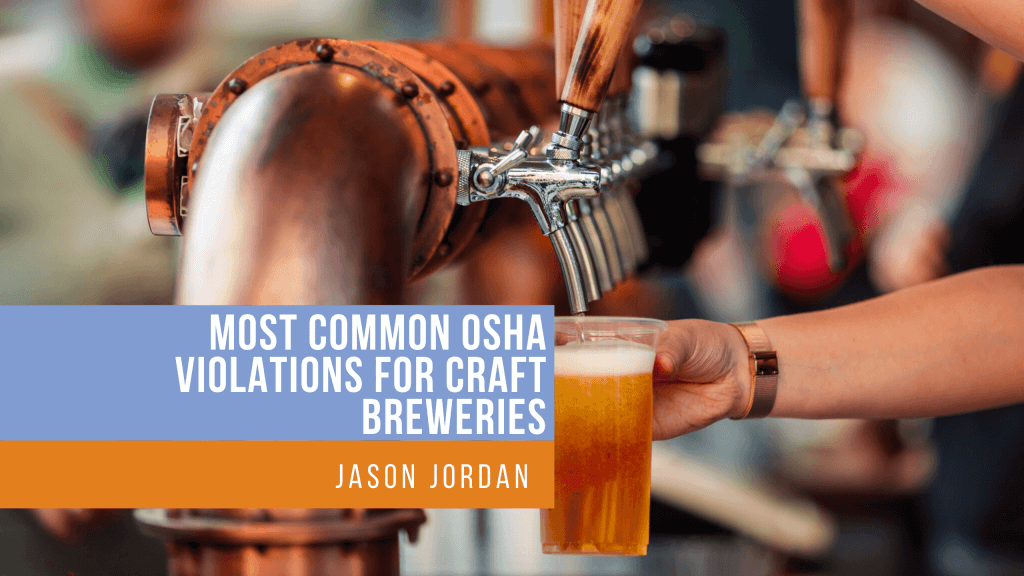Propel provides innovative insurance solutions to thousands of companies across the country. We make it our business to know your world inside and out.
Claims & Risk Management, Employment Practices, Small Business
Most Common OSHA Violations for Craft Breweries
With the growing popularity of craft breweries comes an increasing amount of OSHA violations. In fact, the amount of OSHA violations at breweries more than doubled between 2010 and 2015, according to the Bureau of Labor Statistics.
Craft breweries typically employ brewers who are expected to work with hazardous chemicals and dangerous equipment in confined spaces. Many craft breweries are open to the public for tours and tastings, which exposes them to further liabilities. It is important to understand which OSHA citations brewers are being cited for so they can keep their employees safe and prevent future citations.
29 CFR 1910.146—Permit-required Confined Spaces
Brewers spend time cleaning, servicing and performing maintenance inside equipment such as fermenters, grain silos, mash tuns and kettles. OSHA inspectors commonly cite breweries for failure to provide safe practices while working in such confined spaces.
OSHA defines a “confined space” as an area that meets the following three conditions:
- It is large enough and so configured that an employee can bodily enter and perform assigned work.
- It has limited or restricted means for entry or exit.
- It is not designed for continuous employee occupancy.
Considering their exposure to unique liabilities, it is important to understand what brewers are being cited for so they can keep their employees safe and prevent future citations.
How to Avoid This Violation
OSHA requires several safeguards to ensure safety in confined spaces that could pose hazards to a worker, including the following:
- A written confined-space permit program—OSHA requires a written program that identifies and evaluates the hazards that may be present. It also requires testing the atmospheric conditions of a confined space, and includes instructions for summoning rescue and emergency services.
- Entry permits—Employees must receive an entry permit, signed by the entry supervisor, before performing work in a confined space.
- Worker training—Employers must provide all necessary training for employees who may enter a permit-required confined space.
5A0001—OSHA General Duty Clause
Brewers often transport heavy kegs, bags of grain and other raw materials. Since OSHA does not yet have a specific ergonomics standard, breweries can be cited under the OSHA General Duty Clause, which mandates that employers provide a workplace “free from recognized hazards that are causing or are likely to cause death or serious physical harm.” How to Avoid This Violation Ergonomic injuries are a recognized hazard, which means employers are at risk when they fail to mitigate the dangers associated with improper lifting tasks. Ways to mitigate such risks include the following:
- Regularly train and retrain employees on proper lifting techniques.
- Provide proper tools and equipment—such as forklifts—for lifting heavy items, and ensure employees are properly trained to use them.
- When possible, adjust employees’ schedules so they’re sharing lifting responsibilities equally.
29 CFR 1910.119—Process Safety Management of Highly Hazardous Chemicals
Breweries commonly rely on ammonia refrigeration to keep their supplies cold. However, some brewers fail to realize that ammonia is one of the dangerous chemicals covered under 29 CFR 1910.119, OSHA’s regulation for preventing or minimizing the release of toxic, reactive, flammable or explosive chemicals.
How to Avoid This Violation
Breweries can avoid being cited for this violation and keep employees safe by doing the following:
- Develop a process hazard analysis in accordance with the standard.
- Outline processes for operating and emergency use of refrigeration systems.
- Create written procedures, and train employees to maintain relevant equipment.
29 CFR 1910.147—The Control of Hazardous Energy (Lockout/Tagout)
Lockout/tagout (LOTO) violations are among OSHA’s most common citations each year. Employers must adhere to specific LOTO practices and procedures to protect employees from the unexpected startup of machinery and equipment.
How to Avoid This Violation
- Create a LOTO program that protects employees from all sources of hazardous energy (including
electrical energy, hydraulic pressure, gravity and heat). - Create written procedures that cover the control of hazardous energy.
29 CFR 1910.1200—Hazard Communication
Craft breweries are often cited for violations related to OSHA’s hazard communication regulation, which governs the labeling of chemical hazards in the workplace.
How to Avoid This Violation
- Develop a hazard communication plan.
- Make sure chemicals are completely labeled and accompanied by safety data sheets.
- Train employees on how to handle and monitor the presence of chemicals.
29 CFR 1910.133(a)(1)—Eye and Face Protection
It is important that employees wear the right equipment when working with hazards like boiling water and toxic chemicals. Yet breweries have been repeatedly cited for failure to provide proper personal protective equipment (PPE) to their employees.
How to Avoid This Violation
Employers should adhere to OSHA’s standard for eye and face protection in order to consistently provide appropriate PPE when employees are exposed to hazards mentioned in the standard.
29 CFR 1910.178—Powered Industrial Trucks
Craft breweries regularly rely on powered industrial trucks and forklifts to transport and lift heavy items and raw materials. Still, many breweries have been cited for failing to train employees to safely operate such equipment.
How to Avoid This Violation
OSHA’s requirement for forklifts and powered trucks requires employers to provide training to that meets the following requirements before operating a powered industrial truck:
- Trainees may only operate a forklift or powered truck under the supervision of a colleague or manager equipped with the knowledge, training, and expertise to offer training. The training must be given in a manner that does not endanger any employees.
- Training must include a mix of formal instruction, practical training and an evaluation
of the trainee’s competence. - Training should cover numerous topics related to safely operating powered trucks, including steering, how to use controls and instrumentation, visibility and workplace conditions.
Jason Jordan
As a classically trained chef and insurance expert in the craft beverage industry, Jason has honed his palate for flavors as well as his skills in risk assessment. And he prides himself on his expertise in delivering the quality of service and knowledge, carefully crafted and tested over time, that his clients expect and deserve.
More about Jason...


